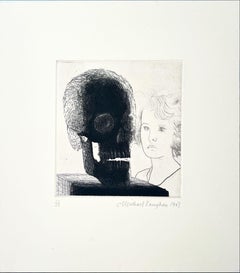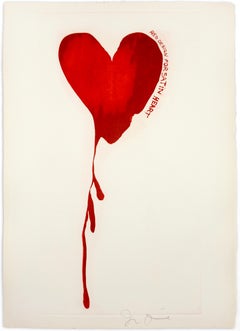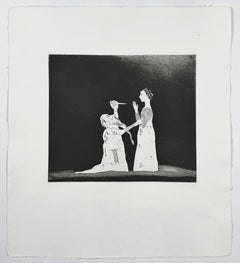Michael Vaughan (British) Art
British, b. 1948
Michael Vaughan was born in London in 1948. He started painting at school under the guidance of the sculptor John Bunting. Later, while studying History at Oxford, he spent considerable time attending classes at the Ruskin School of Art. He continued with his art practice, studying at the RA and at Morley College with Maggi Hambling whilst creating Vaughan Designs, an internationally renowned lighting business, with his wife Lucy.
He worked as creative director there until 2013 when he decided to dedicate himself full-time to painting.
Vaughan's first solo exhibition was in 2015 in London. In the summer of 2018, he exhibited at Rosenberg & Co in New York as part of their group show 'Five Contemporary Artists' and has subsequently had further solo shows in London.to
1
Overall Width
to
Overall Height
to
1
1
1
1
1
1
1
1
1
9,445
2,689
1,375
1,359
1
Artist: Michael Vaughan (British)
Death and the Maiden, 1987 - Monochrome Graphic Etching Print, Black and White
By Michael Vaughan (British)
Located in Kingsclere, GB
Michael Vaughan was born in London in 1948. He started painting at school under the guidance of the sculptor John Bunting. Later, while studying History a...
Category
Late 20th Century Michael Vaughan (British) Art
Materials
Etching
Related Items
Jim Dine Red Design for Satin Heart "The Picture of Dorian Grey" bleeding heart
By Jim Dine
Located in New York, NY
This proof depicts one of Jim Dine's signatures motifs, a deep red heart, which drips down the page. Along the right side of the heart, hand-drawn text reads: “Red design for satin h...
Category
1960s Pop Art Michael Vaughan (British) Art
Materials
Etching
Old Rinkrank threatens the Princess by David Hockney Brothers Grimm Fairy Tales
By David Hockney
Located in New York, NY
This etching from David Hockney’s celebrated Six Fairy Tales from the Brothers Grimm portfolio depicts the somewhat obscure story Old Rinkrank, which Hockney chose to illustrate beca...
Category
1960s Modern Michael Vaughan (British) Art
Materials
Etching, Aquatint
Winter Wildfowling
By Frank Benson
Located in New York, NY
This 1927 etching by Frank W. Benson is entitled Winter Wildfowling. Printed in an edition of 150 this impression is signed in pencil, lower left. The image size 11 7/8 x 9 7/8" (30 x 24.8 cm) and sheet size 15 1/16 x 12 5/8" (38.3 x 32 cm).
FRANK W. BENSON (1862-1951)
Frank Weston Benson, well known for his American impressionist paintings, also produced an incredible body of prints - etchings, drypoints, and a few lithographs. Born and raised on the North Shore of Massachusetts, Benson, a natural outdoorsman, grew up sailing, fishing, and hunting. From a young age, he was fascinated with drawing and birding – this keen interest continued throughout his life.
His first art instruction was with Otto Grundman at the Museum of Fine Arts in Boston, and then in 1883 in Paris at the Academie Julian where he studied the rigorous ‘ecole des beaux arts’ approach to drawing and painting for two years.
During the early 1880’s Seymour Haden visited Boston giving a series of lectures on etching. This introduction to the European etching...
Category
1920s American Impressionist Michael Vaughan (British) Art
Materials
Etching
Running the Rapids
By Frank Benson
Located in New York, NY
The etching "Running the Rapids" was created by Frank Benson in 1927. Printed in an edition of 150, this impression is signed in pencil, lower left. The image size is 5 13/16 x 7 7/8" (14.8 x 20 cm) and sheet size 8 1/16 x 10 5/16" (20.3 x 26.2 cm).
Frank Weston Benson (1862-1951), well known for his American impressionist paintings, also produced an incredible body of prints - etchings, drypoints, and a few lithographs. Born and raised on the North Shore of Massachusetts, Benson, a natural outdoorsman, grew up sailing, fishing, and hunting. From a young age, he was fascinated with drawing and birding – this keen interest continued throughout his life.
His first art instruction was with Otto Grundman at the Museum of Fine Arts in Boston, and then in 1883 in Paris at the Academie Julian where he studied the rigorous ‘ecole des beaux arts’ approach to drawing and painting for two years.
During the early 1880’s Seymour Haden visited Boston giving a series of lectures on etching. This introduction to the European etching...
Category
1920s American Impressionist Michael Vaughan (British) Art
Materials
Etching
Engraving #1 by Ernst Fuchs: KABBALAH (SEFER YETSIRA and 32 PATHS OF WISDOM)
By Ernst Fuchs
Located in Cliffside Park, NJ
Original engraving #7 by Ernst FUCHS from Kabbalah (THIRTY-TWO PATHS OF WISDOM by SEFER YETZIRA), 1978
Etching signed and numbered 16/30 E.A.
Page size - 30 ...
Category
1970s Modern Michael Vaughan (British) Art
Materials
Paper, Etching
Digging up glass by David Hockney (Six Fairy Tales from the Brothers Grimm)
By David Hockney
Located in New York, NY
This etching from David Hockney’s celebrated Six Fairy Tales from the Brothers Grimm portfolio depicts the somewhat obscure story Old Rinkrank, which Hockney chose to illustrate beca...
Category
1960s Modern Michael Vaughan (British) Art
Materials
Etching, Aquatint
A dancing one - XXI Century, Figurative etching print, Black & white
By Leszek Rózga
Located in Warsaw, PL
LESZEK RÓZGA (1924-2015)
He studied painting at Maria Skarbek-Kruszewska private atelier in 1945-46. In 1948, he began studies at the art school in Łódź (later: Academy of Fine Arts)...
Category
Early 2000s Contemporary Michael Vaughan (British) Art
Materials
Paper, Etching
$353
H 6.3 in W 4.93 in
Marc Chagall - Bath-Sheba at the Feet of David - Original Handsigned Etching
By Marc Chagall
Located in Collonge Bellerive, Geneve, CH
Marc Chagall - Bath-Sheba at the Feet of David - Original Handsigned Etching
1958
Printed by Tériade
Dimensions: 54 x 39 cm
Handsigned and numbered
handcolored
Edition: 100
Reference: Cramer 30.
Etching with hand-coloring, circa 1930, initialled in pencil, numbered 75/100 (there were also twenty hors-commerce copies) , published 1958 by Tériade, Paris, on Arches wove paper
Marc Chagall (born in 1887)
Marc Chagall was born in Belarus in 1887 and developed an early interest in art. After studying painting, in 1907 he left Russia for Paris, where he lived in an artist colony on the city’s outskirts. Fusing his own personal, dreamlike imagery with hints of the fauvism and cubism popular in France at the time, Chagall created his most lasting work—including I and the Village (1911)—some of which would be featured in the Salon des Indépendants exhibitions. After returning to Vitebsk for a visit in 1914, the outbreak of WWI trapped Chagall in Russia. He returned to France in 1923 but was forced to flee the country and Nazi persecution during WWII. Finding asylum in the U.S., Chagall became involved in set and costume design before returning to France in 1948. In his later years, he experimented with new art forms and was commissioned to produce numerous large-scale works. Chagall died in St.-Paul-de-Vence in 1985.
The Village
Marc Chagall was born in a small Hassidic community on the outskirts of Vitebsk, Belarus, on July 7, 1887. His father was a fishmonger, and his mother ran a small sundries shop in the village. As a child, Chagall attended the Jewish elementary school, where he studied Hebrew and the Bible, before later attending the Russian public school. He began to learn the fundamentals of drawing during this time, but perhaps more importantly, he absorbed the world around him, storing away the imagery and themes that would feature largely in most of his later work.
At age 19 Chagall enrolled at a private, all-Jewish art school and began his formal education in painting, studying briefly with portrait artist Yehuda Pen. However, he left the school after several months, moving to St. Petersburg in 1907 to study at the Imperial Society for the Protection of Fine Arts. The following year, he enrolled at the Svanseva School, studying with set designer Léon Bakst, whose work had been featured in Sergei Diaghilev's Ballets Russes. This early experience would prove important to Chagall’s later career as well.
Despite this formal instruction, and the widespread popularity of realism in Russia at the time, Chagall was already establishing his own personal style, which featured a more dreamlike unreality and the people, places and imagery that were close to his heart. Some examples from this period are his Window Vitebsk (1908) and My Fianceé with Black Gloves (1909), which pictured Bella Rosenfeld, to whom he had recently become engaged.
The Beehive
Despite his romance with Bella, in 1911 an allowance from Russian parliament member and art patron Maxim Binaver enabled Chagall to move to Paris, France. After settling briefly in the Montparnasse neighborhood, Chagall moved further afield to an artist colony known as La Ruche (“The Beehive”), where he began to work side by side with abstract painters such as Amedeo Modigliani and Fernand Léger as well as the avant-garde poet Guillaume Apollinaire. At their urging, and under the influence of the wildly popular fauvism and cubism, Chagall lightened his palette and pushed his style ever further from reality. I and the Village (1911) and Homage to Apollinaire (1912) are among his early Parisian works, widely considered to be his most successful and representative period.
Though his work stood stylistically apart from his cubist contemporaries, from 1912 to 1914 Chagall exhibited several paintings at the annual Salon des Indépendants exhibition, where works by the likes of Juan Gris, Marcel Duchamp and Robert Delaunay were causing a stir in the Paris art world. Chagall’s popularity began to spread beyond La Ruche, and in May 1914 he traveled to Berlin to help organize his first solo exhibition, at Der Sturm Gallery. Chagall remained in the city until the highly acclaimed show opened that June. He then returned to Vitebsk, unaware of the fateful events to come.
War, Peace and Revolution
In August 1914 the outbreak of World War I precluded Chagall’s plans to return to Paris. The conflict did little to stem the flow of his creative output, however, instead merely giving him direct access to the childhood scenes so essential to his work, as seen in paintings such as Jew in Green (1914) and Over Vitebsk (1914). His paintings from this period also occasionally featured images of the war’s impact on the region, as with Wounded Soldier (1914) and Marching (1915). But despite the hardships of life during wartime, this would also prove to be a joyful period for Chagall. In July 1915 he married Bella, and she gave birth to a daughter, Ida, the following year. Their appearance in works such as Birthday (1915), Bella and Ida by the Window (1917) and several of his “Lovers” paintings give a glimpse of the island of domestic bliss that was Chagall’s amidst the chaos.
To avoid military service and stay with his new family, Chagall took a position as a clerk in the Ministry of War Economy in St. Petersburg. While there he began work on his autobiography and also immersed himself in the local art scene, befriending novelist Boris Pasternak, among others. He also exhibited his work in the city and soon gained considerable recognition. That notoriety would prove important in the aftermath of the 1917 Russian Revolution when he was appointed as the Commissar of Fine Arts in Vitebsk. In his new post, Chagall undertook various projects in the region, including the 1919 founding of the Academy of the Arts. Despite these endeavors, differences among his colleagues eventually disillusioned Chagall. In 1920 he relinquished his position and moved his family to Moscow, the post-revolution capital of Russia.
In Moscow, Chagall was soon commissioned to create sets and costumes for various productions at the Moscow State Yiddish Theater, where he would paint a series of murals titled Introduction to the Jewish Theater as well. In 1921, Chagall also found work as a teacher at a school for war orphans. By 1922, however, Chagall found that his art had fallen out of favor, and seeking new horizons he left Russia for good.
Flight
After a brief stay in Berlin, where he unsuccessfully sought to recover the work exhibited at Der Sturm before the war, Chagall moved his family to Paris in September 1923. Shortly after their arrival, he was commissioned by art dealer and publisher Ambroise Vollard to produce a series of etchings for a new edition of Nikolai Gogol's 1842 novel Dead Souls. Two years later Chagall began work on an illustrated edition of Jean de la Fontaine’s Fables, and in 1930 he created etchings for an illustrated edition of the Old Testament, for which he traveled to Palestine to conduct research.
Chagall’s work during this period brought him new success as an artist and enabled him to travel throughout Europe in the 1930s. He also published his autobiography, My Life (1931), and in 1933 received a retrospective at the Kunsthalle in Basel, Switzerland. But at the same time that Chagall’s popularity was spreading, so, too, was the threat of Fascism and Nazism. Singled out during the cultural "cleansing" undertaken by the Nazis in Germany, Chagall’s work was ordered removed from museums throughout the country. Several pieces were subsequently burned, and others were featured in a 1937 exhibition of “degenerate art” held in Munich. Chagall’s angst regarding these troubling events and the persecution of Jews in general can be seen in his 1938 painting White Crucifixion.
With the eruption of World War II, Chagall and his family moved to the Loire region before moving farther south to Marseilles following the invasion of France. They found a more certain refuge when, in 1941, Chagall’s name was added by the director of the Museum of Modern Art (MOMA) in New York City to a list of artists and intellectuals deemed most at risk from the Nazis’ anti-Jewish campaign. Chagall and his family would be among the more than 2,000 who received visas and escaped this way.
Haunted Harbors
Arriving in New York City in June 1941, Chagall discovered that he was already a well-known artist there and, despite a language barrier, soon became a part of the exiled European artist community. The following year he was commissioned by choreographer Léonide Massine to design sets and costumes for the ballet Aleko, based on Alexander Pushkin’s “The Gypsies” and set to the music of Pyotr Ilyich Tchaikovsky.
But even as he settled into the safety of his temporary home, Chagall’s thoughts were frequently consumed by the fate befalling the Jews of Europe and the destruction of Russia, as paintings such as The Yellow Crucifixion...
Category
1960s Surrealist Michael Vaughan (British) Art
Materials
Etching
$13,214
H 21.26 in W 15.36 in D 0.04 in
Jean Jansem - Original Etching
By Jean Jansem
Located in Collonge Bellerive, Geneve, CH
Jean Jansem - Original Etching
Title: Loneliness
Dimensions: 40 x 30 cm
Edition of 175
Paper: vélin de Rives
1974
Jean Jansem was born in 1920 at Seuleuze in Asia Minor and spent h...
Category
1970s Modern Michael Vaughan (British) Art
Materials
Etching
Engraving #5 by Ernst Fuchs: KABBALAH (SEFER YETSIRA and 32 PATHS OF WISDOM)
By Ernst Fuchs
Located in Cliffside Park, NJ
Original engraving #5 by Ernst FUCHS from Kabbalah (THIRTY-TWO PATHS OF WISDOM by SEFER YETZIRA), 1978
Etching signed and numbered 16/30 E.A.
Page size - 30 x 22 in 76 x 56 cm
Image...
Category
1970s Modern Michael Vaughan (British) Art
Materials
Paper, Etching
Engraving #12 by Ernst Fuchs: KABBALAH (SEFER YETSIRA and 32 PATHS OF WISDOM)
By Ernst Fuchs
Located in Cliffside Park, NJ
Original engraving #12 by Ernst FUCHS from Kabbalah (THIRTY-TWO PATHS OF WISDOM by SEFER YETZIRA), 1978
Etching signed and numbered 16/30 E.A.
Page size - 30 x 22 in 76 x 56 cm
Imag...
Category
1970s Modern Michael Vaughan (British) Art
Materials
Paper, Etching
Engraving #4 by Ernst Fuchs: KABBALAH (SEFER YETSIRA and 32 PATHS OF WISDOM)
By Ernst Fuchs
Located in Cliffside Park, NJ
Original engraving #4 by Ernst FUCHS from Kabbalah (THIRTY-TWO PATHS OF WISDOM by SEFER YETZIRA), 1978
Etching signed and numbered 16/30 E.A.
Page size - 30 x 22 in 76 x 56 cm
Image...
Category
1970s Modern Michael Vaughan (British) Art
Materials
Paper, Etching
Michael Vaughan (british) art for sale on 1stDibs.
Find a wide variety of authentic Michael Vaughan (British) art available for sale on 1stDibs. If you’re browsing the collection of art to introduce a pop of color in a neutral corner of your living room or bedroom, you can find work that includes elements of blue and other colors. You can also browse by medium to find art by Michael Vaughan (British) in gouache, paint, watercolor and more. Not every interior allows for large Michael Vaughan (British) art, so small editions measuring 13 inches across are available. Michael Vaughan (British) art prices can differ depending upon medium, time period and other attributes. On 1stDibs, the price for these items starts at $2,393 and tops out at $4,333, while the average work can sell for $2,522.


